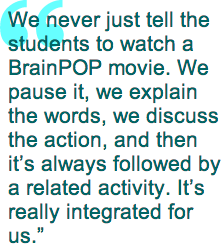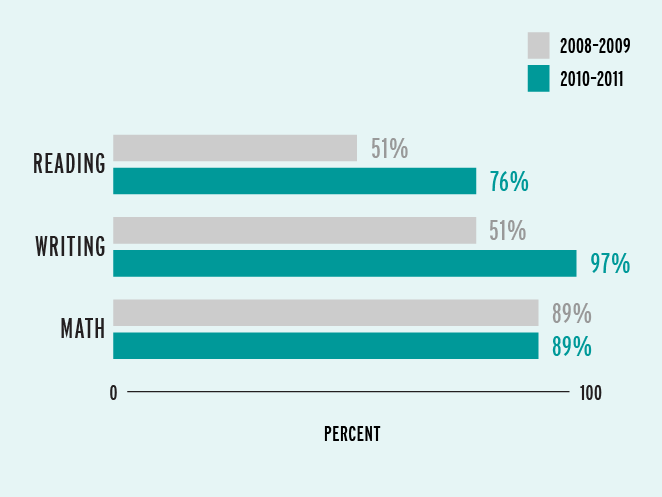Improving Academic Success With BrainPOP Among a Multi-Lingual Student Population in Canada

Cheryl Paige, principal at the Joyce Public School, is justifiably proud of her award-winning school and faculty. Joyce is part of the Toronto District Model Schools for Inner Cities Initiative, and is one of the most multi-cultural, multi-lingual schools in Canada. The elementary school serves approximately 300 pre-K through 6th-grade students and prides itself on math, music, and the effective use of technology in education. Five basic precepts comprise the vision for this school’s success: innovative teaching and learning; support services to ensure the children’s well-being; community involvement; research; and sharing best practices.
Fundamental Challenges
Seventy percent of Joyce students come from homes in which English is not the primary language. In addition, well over half of the students live below the poverty level. In a school with a high immigrant population, where more than 27 languages are spoken, the challenge is to help students learn English and ensure their academic success in all subjects as 6th-graders.
Principal Paige believed that a good technology tool might help her students learn English and master other subject areas as well. To pinpoint the best options, she sought recommendations from her staff of highly qualified, innovative teachers.
Teachers Recommended BrainPOP
The majority of Joyce teachers have won provincial teaching awards (the equivalent of state awards in the United States). Several faculty members have also received national technology innovation awards based on their participation in district-wide projects.
 The teachers are collegial and regularly share best practices. Several of them had taken advantage of free trial subscriptions to BrainPOP. Pleased with what it had to offer, they shared their user experiences at a faculty meeting and enthusiasm to adopt the program began to build.
The teachers are collegial and regularly share best practices. Several of them had taken advantage of free trial subscriptions to BrainPOP. Pleased with what it had to offer, they shared their user experiences at a faculty meeting and enthusiasm to adopt the program began to build.
“My teachers have the passion to make a difference,” said Principal Paige. “So when they came to me and said that BrainPOP would enable us to teach more effectively and help us to provide support for the children so they would be more successful, I supported their decision.”
Once BrainPOP was made available to the entire faculty, teachers found it easy to use as a cross-curriculum tool. Furthermore, BrainPOP provides home access, which allowed Joyce School to extend its learning community into homes, where students and their parents work together to accelerate learning.
Learning English in Context
BrainPOP’s resources include BrainPOP Jr. (K–3), BrainPOP, BrainPOP Español, and BrainPOP ELL. Of those, Principal Paige chose BrainPOP and BrainPOP Jr. (K–3). She was confident these resources would not only help her staff teach difficult subjects like science and math, but naturally put English vocabulary into context for students and help them with reading comprehension. Ninety percent of the Joyce faculty have additional qualifications in the instruction of mathematics and are comfortable with the cross-curriculum approach1.
 Like most of her colleagues, kindergarten teacher Sonia Callea integrates BrainPOP throughout her curriculum, finding it particularly helpful with science and math teaching. Using an interactive whiteboard, a standard feature in all Joyce classrooms, Ms. Callea often opens a new instructional unit with a relevant animated movie from BrainPOP Jr. She follows the movie with discussion and one of the games or quizzes. Then the students move to either a science experiment or hands-on math activity such as measurement or estimation.
Like most of her colleagues, kindergarten teacher Sonia Callea integrates BrainPOP throughout her curriculum, finding it particularly helpful with science and math teaching. Using an interactive whiteboard, a standard feature in all Joyce classrooms, Ms. Callea often opens a new instructional unit with a relevant animated movie from BrainPOP Jr. She follows the movie with discussion and one of the games or quizzes. Then the students move to either a science experiment or hands-on math activity such as measurement or estimation.
“Most of the children in our school don’t have much background in these topics, so being able to watch a movie as opposed to just listening to stories [about the topics] makes it much more meaningful for them,” said Ms. Callea. “BrainPOP helps us incorporate all the different modalities into our instruction and that helps the students learn.”
Andrea Brow, a 2nd-grade teacher, notes that BrainPOP is an ideal tool for students who lack strong auditory skills and may be struggling with language acquisition. These students pick up a lot by watching the videos and then participating in follow-up activities.
 “We never just tell the students to watch a BrainPOP movie. We pause it, we explain the words, we discuss the action, and then it’s always followed by a related activity. It’s really integrated for us.”
“We never just tell the students to watch a BrainPOP movie. We pause it, we explain the words, we discuss the action, and then it’s always followed by a related activity. It’s really integrated for us.”
Teacher Chris Lee attributes BrainPOP’s success as an immersion tool to the fact that it is an enjoyable, engaging experience for students.
“BrainPOP is an amazing resource where students have the opportunity to learn in various environments and different modes as well: student-directed, teacher-directed, or project-based.” He also noted that BrainPOP allows students to grow as independent learners, a skill they will use for the rest of their lives.
Mr. Lee identified two particular BrainPOP features as especially valuable with his students.
“The read-aloud feature from BrainPOP Jr. is very beneficial for students who need the assistance of reading certain words and hearing them being spoken. The closed captioning is also an advantage as I have observed many of my students using this feature on their own time — a plus when engaging visual learners.”
 Mr. Lee routinely begins a new unit with a BrainPOP movie as an introduction to the topic for his students. For example, part of the 4th- and 5th-grade curriculum focuses on understanding the human body, and he finds the BrainPOP content helpful in teaching students about their own bodies and how the different systems work together. BrainPOP includes an overview movie on the human body’s various systems plus individual movies on each of the systems.
Mr. Lee routinely begins a new unit with a BrainPOP movie as an introduction to the topic for his students. For example, part of the 4th- and 5th-grade curriculum focuses on understanding the human body, and he finds the BrainPOP content helpful in teaching students about their own bodies and how the different systems work together. BrainPOP includes an overview movie on the human body’s various systems plus individual movies on each of the systems.
“BrainPOP makes it interesting for them and they can pause or fast forward to repeat or accelerate the learning for themselves.”
Additional Benefits
Students at Joyce who do not speak English seem to identify with the BrainPOP character Moby, the robot who communicates only with beeps instead of words. Most children find Moby hilarious and will watch the movies over and over. While many of the Joyce educators incorporate particular BrainPOP units into their teaching, the program is intuitive enough for students to explore on their own. Some students become so engaged in the program that they work independently both at school and home, quickly gaining a proficiency in academic-focused English and content-specific skills.
 Several Joyce teachers also noted that because BrainPOP is a closed system, they felt comfortable letting their students search for topics independently. They knew that their students would not find inappropriate content as they might while searching the Internet.
Several Joyce teachers also noted that because BrainPOP is a closed system, they felt comfortable letting their students search for topics independently. They knew that their students would not find inappropriate content as they might while searching the Internet.
Beyond school, parent outreach plays a strong role in student success as well. Early last year, more than 100 parents attended an evening training session that addressed the use of educational technology including BrainPOP. The parents were each given an instruction sheet with log-in information and encouraged to access the BrainPOP site with their children. Active parent participation in the learning process contributed to the students’ success.
Test Results
Most of the Joyce teachers who responded to a monthly survey felt that their students were more engaged in lessons and more successful in learning with BrainPOP integrated into the curriculum. Teachers found that using BrainPOP to enrich their lessons and to encourage independent learning across multiple subject areas resulted in accelerated language acquisition. (They reported using BrainPOP to address a variety of subjects areas, including English language arts, math, science, social studies, health, computers, and life skills.)
2010–2011 annual testing of 3rd-graders at Joyce School by the Ontario Education Quality and Accountability Office (EQAO) showed significant proficiency increases in two of three content areas compared to the 2008–2009 school year, before BrainPOP was introduced school-wide.

In addition, a much higher percentage of 3rd graders at Joyce achieved at the highest EQAO performance level in mathematics (Level 4, “above the provincial standard”) compared to 3rd graders across the Toronto District School Board (42 percent for Joyce v. 17 percent across Toronto).
Principal Paige concludes, “When we analyze the factors that cause students to not score well on standardized English language tests, it is usually vocabulary. BrainPOP helps us improve that. For instance, you want to teach about a farm. You read to them about a farm, you put a three-dimensional farm in the classroom, you bring in pictures of farms, and in the clips they can actually see and hear a horse. It’s more powerful — it makes it more real. It’s engaging. It’s 21st-century teaching.”
1 BrainPOP’s American and British English versions are most appropriate for English-speaking Ontario. For French-speaking Canada, the same breadth of cross-curricular topics can be found on BrainPOP Français.











